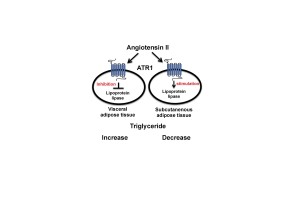Uchiyama T, Sato K, Okajima F (IMCR, Gunma Univ.) Tomono S (Gunma University School of Health Sciences) Nakamura T(Clinical Investigation Unit, Gunma Univ.) Kurabayashi M (Gunma Univ. Graduate School of Medicine)
About
Metabolic syndrome is characterized by visceral adiposity, insulin resistance, high triglyceride (TG)- and low high-density lipoprotein cholesterol-levels, hypertension, and diabetes-all of which often cause cardiovascular and cerebrovascular diseases. It remains unclear, however, why visceral adiposity but not subcutaneous adiposity causes insulin resistance and other pathological situations. Lipoprotein lipase (LPL) catalyzes hydrolysis of TG in plasma lipoproteins. In the present study, we investigated whether the effects of angiotensin II (AngII) on TG metabolism are mediated through an effect on LPL expression. Adipose tissues were divided into visceral adipose tissue (VAT) and subcutaneous adipose tissue (SAT) for comparison. AngII accelerated LPL expression in SAT but, on the contrary, suppressed its expression in VAT. In both SAT and VAT, AngII signaled through the same type 1 receptor. In SAT, AngII increased LPL expression via c-Src and p38 MAPK signaling. In VAT, however, AngII reduced LPL expression via the Gq class of G proteins and the subsequent phospholipase C β4 (PLCβ4), protein kinase C β1, nuclear factor κB, and inducible nitric oxide synthase signaling pathways. PLCβ4 small interfering RNA experiments showed that PLCβ4 expression is important for the AngII-induced LPL reduction in VAT, in which PLCβ4 expression increases in the evening and falls at night. Interestingly, PLCβ4 expression in VAT decreased with fasting, while AngII did not decrease LPL expression in VAT in a fasting state. In conclusion, AngII reduces LPL expression through PLCβ4, the expression of which is regulated by feeding in VAT, whereas AngII increases LPL expression in SAT. The different effects of AngII on LPL expression and, hence, TG metabolism in VAT and SAT may partly explain their different contributions to the development of metabolic syndrome.
Paper information
Angiotensin II Reduces Lipoprotein Lipase Expression in Visceral Adipose Tissue via Phospholipase C β4 Depending on Feeding but Increases Lipoprotein Lipase Expression in Subcutaneous Adipose Tissue via c-Src.
Uchiyama T, Tomono S, Sato K, Nakamura T, Kurabayashi M, Okajima F.
PLos One 10: e0139638 2015
Online URL
http://www.ncbi.nlm.nih.gov/pubmed/26447765
Lab HP
http://signal-transduction.imcr.gunma-u.ac.jp/top%28E%29.html







